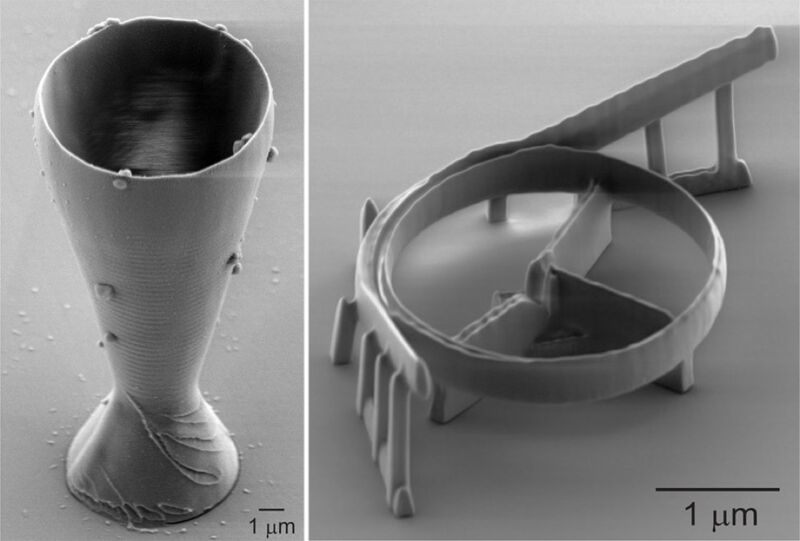
KTH Royal Institute of Technology
A team of Swedish scientists has developed a new 3D printing technique for silica glass that streamlines a complicated energy-intensive process. As a proof of concept, they have 3D printed the world’s smallest wine glass (made from real glass) with a rim smaller than the width of one human hair, as well as an optical resonator for fiber optic telecommunications systems – one of many possible applications for 3D printed components of silica glass. They described their new method in a recent paper in the journal Nature Communications.
“The backbone of the Internet is based on optical fibers made of glass,” said co-author Kristinn Gylfason of the KTH Royal Institute of Technology in Stockholm. “Those systems require all kinds of filters and couplings that can now be 3D printed by our technique. That opens up many new possibilities.”
Silica glass (i.e., amorphous silicon dioxide) is one material that the authors say remains a challenge for 3D printing, particularly at the microscale, although there are several methods to address that challenge, including stereolithography, direct ink writing, and digital light processing. Even those have only been able to achieve feature sizes on the order of a few tens of micrometers, barring a 2021 study that reported nanoscale resolution.
But all of those use sol-gel processes with various organic mixtures loaded with silica nanoparticles. Thus, the final printed structures are composites with many organic materials, lacking the most desirable properties of silica glass (i.e. thermal and chemical stability, hardness, optical transparency over a wide range of wavelengths). It requires an additional sintering step at high temperatures of about 1,200° Celsius (2,192° F) for several hours to remove the organic residues and achieve those properties. That energy-intensive extra step severely limits potential applications, because only substrate materials that can withstand such high temperatures can be used. Some approaches also require assembling 3D-printed structures into a final shape, which is challenging on a micrometer scale.
In developing their alternative technique for 3D printing silica glass, Gylfason et al. converted to hydrogen silsesquioxane (HSQ), an inorganic material similar to silica that can be formed by electron beams, ion beams and certain wavelengths of UV light. A major advantage is that their method does not rely on organic compounds to act as photoinitiators or binders that remain on the substrate, as in stereolithography or direct-ink writing. Instead, their method relies on direct cross-linking of the inorganic HSQ.
The process has three main steps. First, they drop-cast HSQ dissolved in organic solvents onto a substrate. Once the HSQ dries, they trace the desired 3D shape using a focused sub-picosecond laser beam. Finally, any unexposed HSQ is dissolved with the convenient application of a potassium hydroxide solution. Raman spectroscopy of the printed microstructures showed all expected characteristics for silica glass.
However, there were also traces of residual hydrogen and carbon. For applications requiring a purer silica glass, residual organics can be removed by annealing the structures at 900° Celsius (1,652° F) – an additional step, admittedly, but at a much lower temperature than the usual additional sintering step. Thereafter, the spectrum for the structures matched that of a commercial fused silica glass substrate. While annealing 3D-printed microstructures can cause them to shrink or deform, the authors found that the maximum shrinkage for their silica glass structures was about 6 percent, compared to between 16 percent and 56 percent for glass objects made using stereolithography and direct ink writing methods. .
In addition to the proof-of-concept small wine glass and optical resonator, the authors printed a small version of the KTH logo, a cantilever and a conical spiral, as well as a silica glass fiber optic tip. They believe their method could also be used to create custom lenses for medical devices and microrobots. Coating the 3D-printed microstructures with nanodiamonds or ferro nanoparticles may allow further tailoring of the properties for hybrid quantum photonics integration or magnetically remove the motion control of the structures.
“The concerns of integrating 3D printing methods tend to be different for different applications,” said study co-author Po-Han Huang, a graduate student at KTH. “While optimization of our method is still required for various applications, we believe our method represents an important and necessary breakthrough for using 3D glass printing in practical scenarios.”
DOI: Nature Communications, 2023. 10.1038/s41467-023-38996-3 (About DOIs).

